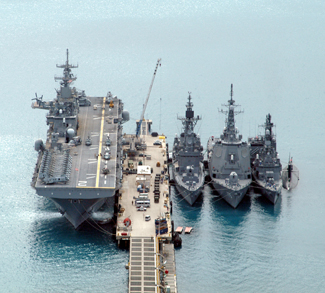With China determined to uphold its ‘core’ national interests, and the US and others equally committed to, for instance, freedom of navigation through the South China Sea, it only needs a spark to ignite a prairie fire
Even as Iran has come centre-stage of another likely military conflict in the Middle East with the US and its western allies determined to force it to forgo its nuclear programme, the Asia-Pacific region is emerging as another potential trouble spot pitting China against the US. With the US now disengaged from Iraq, and in the process of military withdrawal from Afghanistan by 2014, it has dawned on Washington that China has strengthened its role in the Asia-Pacific and is slowly, but steadily, working to push it out of the region. China regards the Asia-Pacific as its strategic space and the US as an external power. The US has decided to hit back by declaring that it is not going anywhere and, indeed, will beef up its military presence in the region. Straddling both the Pacific and the Atlantic Oceans, the US considers itself a legitimate Pacific country.
US-China relations have never been easy. They are likely to become even more complicated after the recent announcement of a US defence review that prioritises the Asia-Pacific region. Even though the review seeks to make sizeable cuts of about $ 500 billion in the US’s defence budget over the next 10 years, it would not be at the cost of its engagement with the Asia-Pacific region. Indeed, as President Obama told reporters, “We will be strengthening our presence in the Asia-Pacific…”
Washington’s decision to make the Asia-Pacific a priority strategic area was presaged during Obama’s recent visit to Australia. He hit out at China on a wide range of issues, while announcing an enhanced US role, including the use of Australian bases/facilities for an effective military presence. He urged China to act like a “grown up” and play by the rules. Elaborating on this in an address to the Australian parliament, he said, “We need growth that is fair, where every nation plays by the rules; where workers’ rights are respected and our businesses can compete on a level playing field; where the intellectual property and new technologies that fuel innovation are protected; and where currencies are market-driven, so no nation has an unfair advantage.”
This catalogue of US economic grievances against China has been the subject of intermittent discussions between the two countries without any satisfactory results. On the question of human rights and freedoms in China, Obama said, “Prosperity without freedom is just another form of poverty.”
The US is upping the ante in its relations with China, with Asia-Pacific centre-stage. It does not accept China’s sovereignty claims in the South China Sea and its island chains. This has caused naval incidents with Vietnam, the Philippines, and with Japan in the East China Sea, and a close naval skirmish or two with the US. As part of a new resolve to play a more assertive role, the US has reinforced and strengthened its strategic ties with Vietnam, the Philippines, India, Australia and Japan.
In announcing cuts to the defence budget over the next decade, President Obama seemed keen to dispel the notion that this would make the US a lesser military power. He said, “The world must know — the US is going to maintain our military superiority with armed forces that are agile, flexible and ready for the full range of contingencies and threats.”
The US’s continued military superiority has a catch though, which is that the US will be adjusting its long-standing doctrine of being able to wage two wars simultaneously. Defence Secretary Leon Panetta maintains that the US military would still be able to confront more than one threat at a time by being more flexible and adaptable than in the past.
Be that as it may, the increased focus on Asia-Pacific has upset China. Its hope of making the region into its own strategic backyard, with the US distracted in the Middle East and its economy in the doldrums, might not be that easy with the new US strategic doctrine prioritising Asia-Pacific. Not surprisingly, the Chinese media has not reacted kindly to it. According to the Chinese news agency Xinhua, “…the US should abstain from flexing its muscles, as this will not help solve regional disputes.” It added, “If the US indiscreetly applies militarism in the region, it will be like a bull in a china shop [literally and figuratively], and endanger peace instead of enhancing regional stability.”
The Global Times called on the Chinese government to develop more long-range strike weapons to deter the US Navy.
Australia, the US’s closet regional ally, fears that China’s rising economic and military power has the potential of destabilising the region. Foreign Minister Kevin Rudd hopes though (as he told the Asia Society in New York) that there was “nothing inevitable” about a future war between the US and China, emphasising the need to craft a regional architecture that recognised the coexistence of both countries, and the acceptance of US alliances in the region. He also saw hope (as a counterpoint to China) in the “collective economic might of Japan, India, Korea, Indonesia and Australia,” which means that, hopefully, China’s perceived threat might be balanced and contained with the US’s enhanced commitment to the region, and the rising clout of a cluster of regional countries.
There are any number of issues that could become a flashpoint for future conflict, like Taiwan, Korea, the South China Sea and its islands, the maritime dispute with Japan and so on. With China determined to uphold its ‘core’ national interests, and the US and others equally committed to, for instance, freedom of navigation through the South China Sea, it only needs a spark to ignite a prairie fire.
As it is, neither China nor the US wants military conflict between their two countries. China’s official position was expounded the other day in Beijing by its Vice-President Xi Jinping, who is also the country’s president-in-waiting. Xi, who is expected to visit the US next month, hoped that “the US can view China’s strategic intentions…in a sensible and objective way, and be committed to develop a cooperative partnership”. And he emphasised that: “Ultimate caution should be given to major and sensitive issues that concern each country’s core interests to avoid any distraction and setbacks in China-US relations.”
The problem, though, is that when it comes to ‘core interests’, objectivity is generally the first casualty. For instance, the US complains that China’s strategic doctrine, if there is one, lacks transparency. The double-digit growth in China’s defence budget, as viewed in Washington, is way beyond its defensive needs. On the other hand, the US has the largest defence budget of any country in the world. It is pertinent to remember that wars have often been caused by miscalculation rather than deliberation. And this is even more so when an emerging power is staking its claims impinging on the existing superpower’s perceived interests and/or seen to be threatening its regional allies. This is how the two World Wars started.
One can only hope that China and the US will carve out a new peaceful way of coexistence and cooperation, though the past experience in such situations is not very encouraging. Indeed, it points to the inevitability of a potential military conflict sooner or later.



